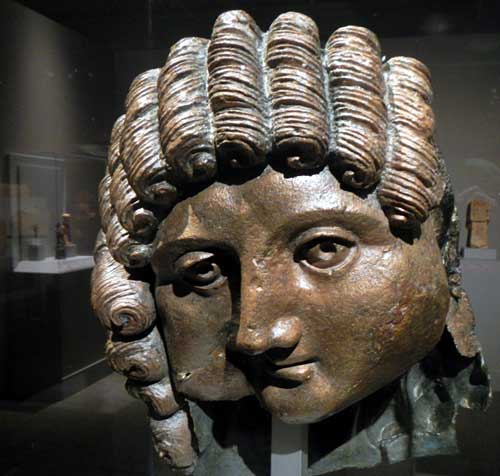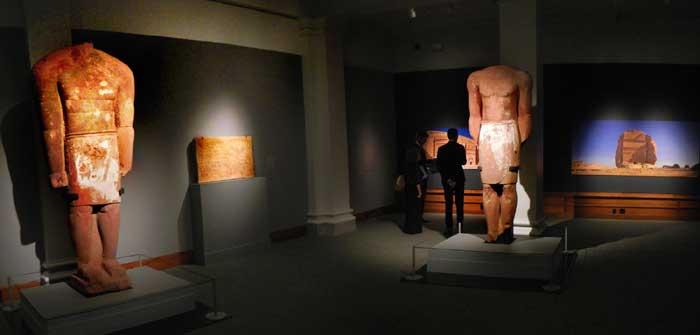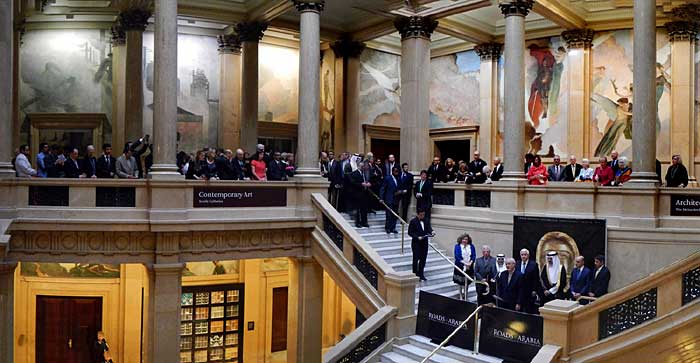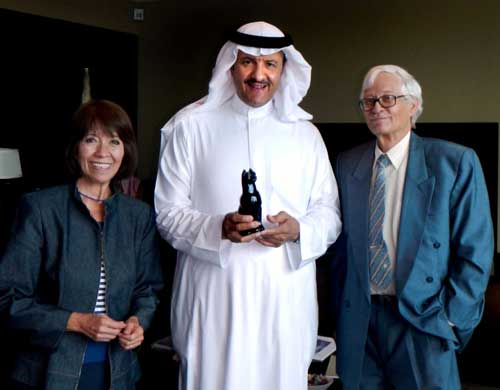|
By John Pint
 His Royal Highness Prince Sultan
bin Salman of Saudi Arabia and
Governor Tom Corbett of Pennsylvania launched an astonishing exhibit of
artifacts entitled Roads of Arabia at the Carnegie Museum of Natural
History in Pittsburgh, Pennsylvania, USA on June 21, 2013. His Royal Highness Prince Sultan
bin Salman of Saudi Arabia and
Governor Tom Corbett of Pennsylvania launched an astonishing exhibit of
artifacts entitled Roads of Arabia at the Carnegie Museum of Natural
History in Pittsburgh, Pennsylvania, USA on June 21, 2013.
The 240
pieces on display tell the story of life and art in the Arabian
Peninsula from 7,000 years ago to the early 20th century. I am happy to
report that Saudicaves was on hand for this event, thanks to a kind
invitation extended by the Prince himself, but before describing what
can only be called a landmark exhibition, I must say a word about an
aspect of the evening that will probably not be recorded by other
journalists.
A crowd of
about 200 people attended the inauguration ceremonies and
dinner. Many of them were benefactors of the Carnegie Museum or
sponsors of the event. The others, my wife and I discovered as we
mingled with them, turned out to be “just people” from all walks of
life who, over the years, had formed warm bonds of friendship with
Prince Sultan.
Take
Betty Murphy, widow of Pat Murphy, former publisher of the Arizona
Republic and Phoenix Gazette, whose family became acquainted with
Prince Sultan at age 17 when he attended the University of Arizona. "It
has been a wonderful relationship and we are so proud of what he has
accomplished in his young life," she said.
Well, this
was a theme we heard again and again. We heard it from Ken
Hoffman, who taught Sultan to fly a plane and from Doctor Michael Saba,
who got to know the Prince while writing a book on Captain Joe Grant,
the pilot of an airplane donated to King Abdulaziz 1945 by Franklin
Delano Roosevelt (“King Abdulaziz, his Plane and his Pilot” published
by Gulf America Press in 2009). Again, this theme was echoed by
Governor Corbett, who began his speech by saying, “This encounter with
Prince Sultan has been an absolute treat for me and if I ever need a
tourist guide, somewhere in the world, I’m coming to him.”

Colossal
sandstone statues from the 4th to 3rd century
B.C., recently discovered at al-‘Ula in northern Saudi Arabia and now
on display at the Carnegie Museum in Pittsburgh. The men are wearing
belted skirts which were originally painted with white plaster. Photo
by J. Pint
So, what
archaeological wonders did Prince Sultan, who is the head of
the Saudi Commission for Tourism and Antiquities, bring with him to
Pittsburgh? Well, I think few people would have expected breathtaking
sandstone statues of Lihyanite kings dating back 6000 years,
anthropomorphic stelae from the 4th millennium BC, a bronze head in the
Greco-Roman tradition and even the gold burial mask of a six-year-old
girl (1 AD), found in a tomb outside the fabled city of Thaj. In
addition, for the very first time outside Arabia, we see an object from
the Ka’aba in Mecca, an ornate wooden door gilded in silver leaf,
dating back to the Ottoman period.
This
collection of ancient treasures from Arabia was first put on
display at the Louvre in Paris in 2010. This is quite astonishing
considering that only thirty years earlier, there were few
archaeologists and few museums in the country, even though the Arabian
Peninsula has a long and rich history.

Inauguration of the Exhibition “Roads of Arabia:
Archaeology and History of the Kingdom of Saudi Arabia” by Saudi Prince
Sultan bin Salman at the Carnegie Museum of Natural History in
Pittsburgh. This collection was first shown at the Louvre in Paris in
2010. Photo by J. Pint
In his speech
at the Carnegie Museum, Prince Sultan said he hoped that
this exhibit would “tell a story and open a window” and he stated that
“What is happening in Saudi Arabia today is beyond belief.” I think he
was referring to a fresh, new outlook permeating Saudi society, an
outlook which he said paralleled his own experience as an astronaut,
when he flew aboard the Space Shuttle Discovery in 1985. “On the first
day,” he continued, “we looked at Earth and each of us pointed out our
countries; on the second day we were referring to continents and by the
fifth day we were only aware of one place, our earth: how small it is,
out there in the middle of nowhere.”
Some thirty
years ago, when I first went to live and work in Saudi
Arabia, archaeology and ancient sites were looked upon differently than
today.
In
particular, I remember facing the wrath of an angry guard at the
ruins of Al ‘Ula, in northern Saudi Arabia, which was a commercial hub
linking Syria and Egypt with southern Arabia in the 6th century B.C. It
was a tourist site, but the guard was upset because we had spent two
hours visiting the fascinating oven tombs of Al Ula. “Why did you take
so long when most people only stay for 15 minutes?” he cried, “and why
are you carrying two cameras?” Fortunately, we had in our party a
speaker of fluent Arabic who was finally able to convince the old man
that I was not a spy, as he imagined, but simply a person who genuinely
appreciated that ancient site…and wanted to get really good pictures of
it.
The point of
view of that old guard may give some idea of the sort of
obstacles that Prince Sultan has had to overcome during his years as
head of the Saudi Commission on Antiquities.
As a cave
explorer and a former consultant to the Saudi Geological
Survey, I suspect that many more astounding treasures will be unearthed
in Arabia simply because no archaeologist has yet (to my knowledge)
carried out a single study inside the many subterranean passages which
lie beneath this vast country’s deserts and mountains. Just by way of
example, let me mention a lava field north of Medina called Harrat
Khaybar where we explored a system of lava tubes 1.4 kilometers long
(and probably well over a million years old), now known as Umm Jirsan
Cave. Deep inside, we found what seem to be crude knives and
scrapers made of basalt as well as two human skull caps carbon-dated at
4000 years before present. All of these were lying on a dirt floor at
least two meters deep. What ancient marvels will be found once shovels
are used to dig down beneath the surface? Considering that mankind’s
forebears have been passing next to and through Harrat Khaybar nonstop
for at least the last 70,000 years, we could expect to find a fine
record of human history inside those caves. And the best part of all is
that there are at least 400 kilometers more of huge lava-tube passages
in this area, none of which have been studied or mapped. For more on
the archaeological potential of Saudi caves, see The
Lava Caves of
Khaybar .
The
stupendous pieces in the Roads of Arabia exhibit may someday be
considered only the tip of the iceberg as far as the archaeological
treasures of Saudi Arabia—and the world—are concerned.
Many thanks
to Prince Sultan bin Salman for inviting Susy and me to
Pittsburgh and I hope, after touring the USA, that this extraordinary
collection will next head south into Mexico where we make our home.
You can see
more of the articles on display in Pittsburgh at Roads of
Arabia.
 John and Susy Pint, founders of
Saudicaves.com, present Prince Sultan of Saudi Arabia with the statue
of a cat carved
in rainbow obsidian from Jalisco, Mexico. The Pints were invited by the
Prince to Pittsburgh for the
inauguration of the Roads of Arabia archaeological exhibition.
John and Susy Pint, founders of
Saudicaves.com, present Prince Sultan of Saudi Arabia with the statue
of a cat carved
in rainbow obsidian from Jalisco, Mexico. The Pints were invited by the
Prince to Pittsburgh for the
inauguration of the Roads of Arabia archaeological exhibition.
|

